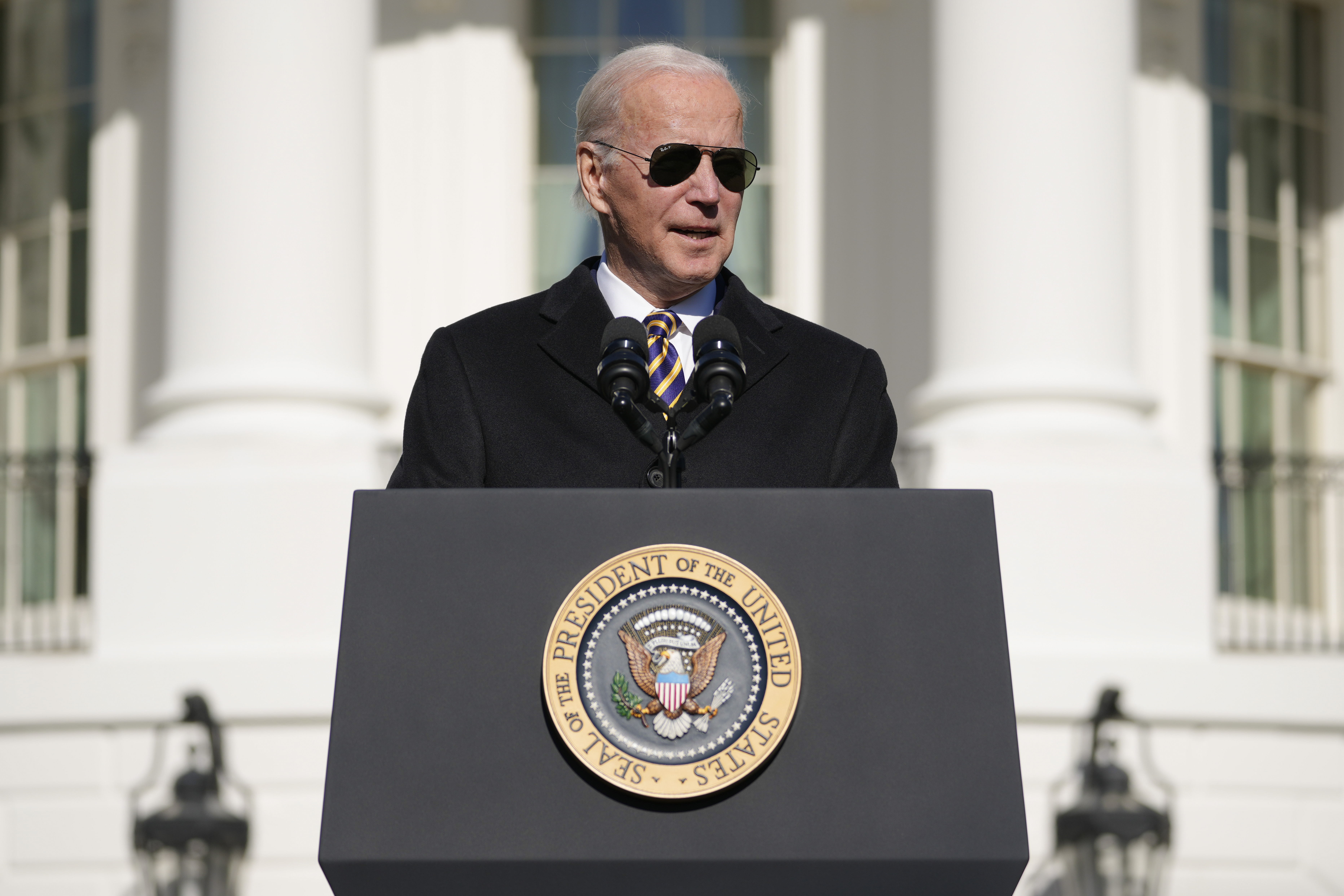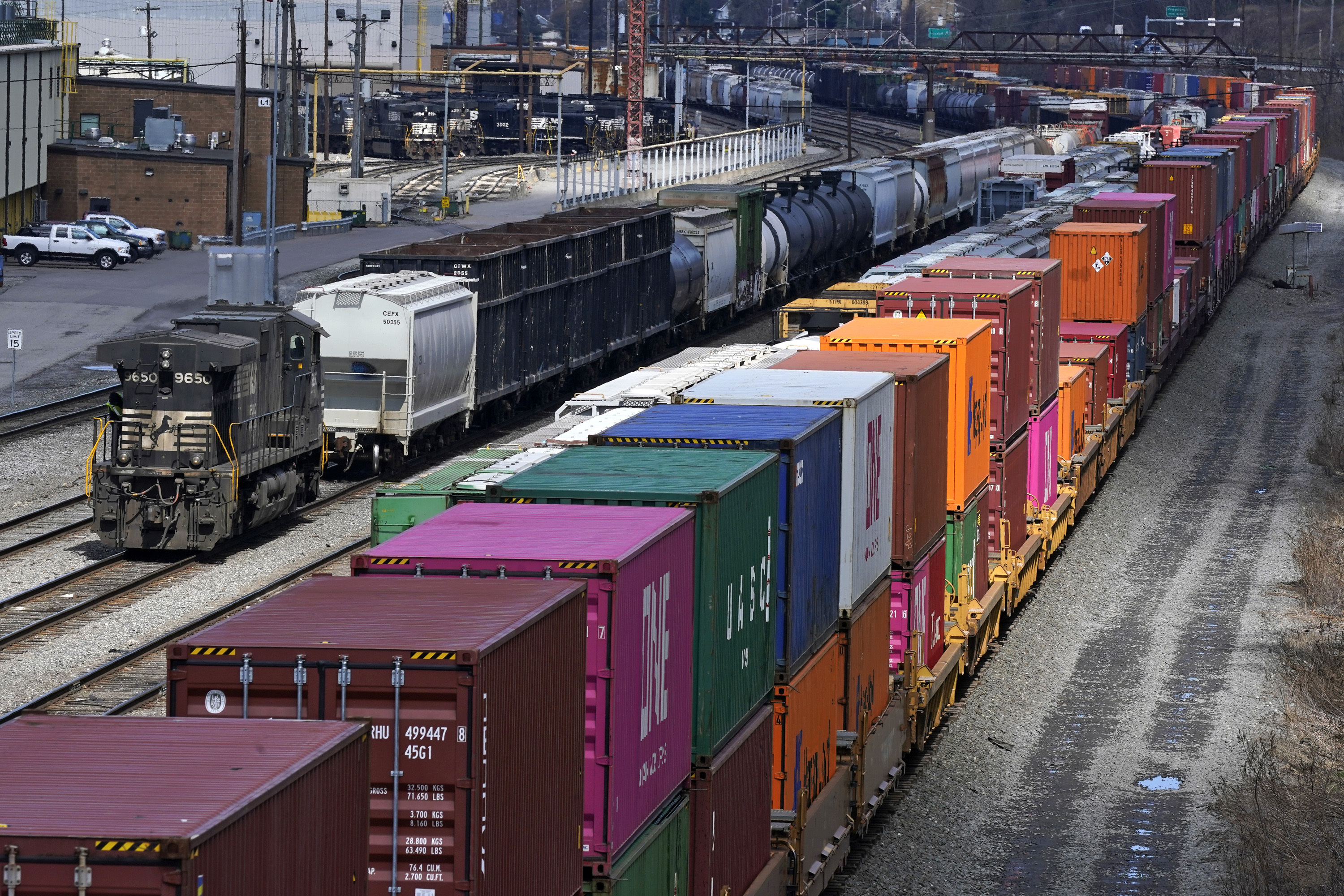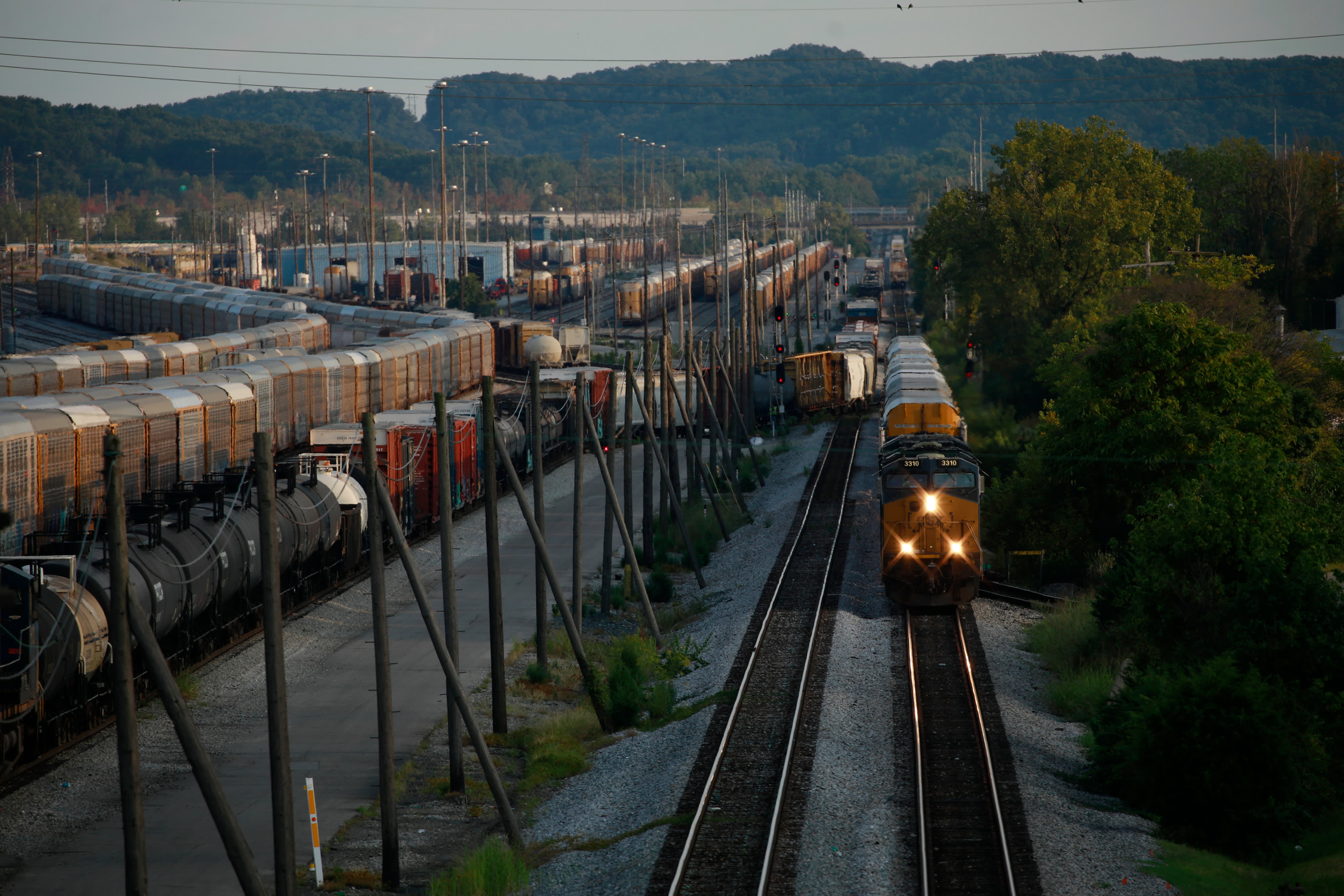As a busy holiday season gets underway, the looming threat of a potentially "devastating" rail strike is back.
President Joe Biden on Monday asked Congress to intervene and block a railroad strike before next month’s deadline in the stalled contract talks, and House Speaker Nancy Pelosi said lawmakers would take up legislation this week to impose the deal that unions agreed to in September.
“Let me be clear: a rail shutdown would devastate our economy,” Biden said in a statement. “Without freight rail, many U.S. industries would shut down.”
Feeling out of the loop? We'll catch you up on the Chicago news you need to know. Sign up for the weekly Chicago Catch-Up newsletter here.
Biden also said noted that that a rail freight shutdown amid the holiday season would be "devastating." "Congress should get this bill to my desk as soon as possible so we can avoid disruption," the statement continued.
Pelosi, in a statement, said: “We are reluctant to bypass the standard ratification process for the Tentative Agreement — but we must act to prevent a catastrophic nationwide rail strike, which would grind our economy to a halt.”
Pelosi said the House would not change the terms of the September agreement, which would challenge the Senate to approve the House bill without changes.
What Unions Are Saying
On Monday, the Association of American Railroads trade group praised Biden’s action.
“No one benefits from a rail work stoppage — not our customers, not rail employees and not the American economy,” said AAR President and CEO Ian Jefferies. “Now is the appropriate time for Congress to pass legislation to implement the agreements already ratified by eight of the twelve unions.”
Business groups that have been pushing for Congress to settle this contract dispute praised Biden’s move.
“The Biden administration’s endorsement of congressional intervention affirms what America’s food, beverage, household and personal care manufacturers have been saying: Freight rail operations cannot shut down and imperil the availability and affordability of consumers’ everyday essentials,” said Tom Madrecki, vice president of supply chain for the Consumer Brands Association. “The consequences to consumers if a strike were to occur are too serious, especially amid continued supply chain challenges and disruptions.”
Clark Ballew, a spokesman for the Brotherhood of Maintenance of Way Employes Division, which represents track maintenance workers, said before Biden’s announcement that the union was “headed to D.C. this week to meet with lawmakers on the Hill from both parties. We have instructed our members to contact their federal lawmakers in the House and Senate for several weeks now.”
The U.S. Chamber of Commerce’s Neil Bradley said Biden was correct in advocating for the deal already reached. “Congress must do what it has done 18 times before: intervene against a national rail strike,” Bradley said in a statement, and he called Congress enforcing the deal agreed to by railroads and union leaders the “only path to avoid crippling strike.”
The railroads, which include Union Pacific, BNSF, Norfolk Southern, CSX and Kansas City Southern, wanted any deal to closely follow the recommendations a special board of arbitrators that Biden appointed made this summer that called for the 24% raises and $5,000 in bonuses but didn’t resolve workers’ concerns about demanding schedules that make it hard to take a day off and other working conditions. That’s what Biden is calling on Congress to impose.
The Current "Tentative" Agreement Went Into Effect in September
A rail way worker strike was averted in September, just days before a crucial deadline, after a "tentative" railway labor agreement between labor unions and railroad companies was been reached.
At that time, in the Chicago area, Metra and Amtrak — neither of which are part of, or have a say in the labor dispute — had prepared for a potential strike by pre-emptively canceling multiple busy commuter and long-distance train schedules on lines that are owned, maintained and dispatched by freight railroads.
However, as the next crucial deadline approaches on Dec. 9, the risk of a strike has returned.
One of the biggest rail unions rejected a deal last week, joining three others that have failed to approve contracts over concerns about demanding schedules and the lack of paid sick time.
The September agreement that Biden and Pelosi are calling for is a slight improvement over what the board of arbitrators recommended in the summer. The September agreement added three unpaid days off a year for engineers and conductors to tend to medical appointments as long as they scheduled them at least 30 days in advance. The railroads also promised in September not to penalize workers who are hospitalized and to negotiate further with the unions after the contract is approved about improving the regular scheduling of days off.
Both the unions and railroads have been lobbying Congress while contract talks continue, and hundreds of business groups have been urging Congress and the president to step into the deadlocked contract talk and prevent a strike. If Congress acts, it will end talks between the railroads and four rail unions that rejected their deals Biden helped broker before the original strike deadline in September. Eight other unions have approved their five-year deals with the railroads and are in the process of getting back pay for their workers for the 24% raises that are retroactive to 2020.
If Congress does what Biden suggests and imposes terms similar to what was agreed on in September, that will end the union’s push to add paid sick time. The four unions that have rejected their deals have been pressing for the railroads to add that benefit to help address workers’ quality of life concerns, but the railroads had refused to consider that.
Biden said that as a “a proud pro-labor president” he was reluctant to override the views of people who voted against the agreement. “But in this case — where the economic impact of a shutdown would hurt millions of other working people and families — I believe Congress must use its powers to adopt this deal.”
How a Potential Rail Strike Will Affect You Even if You Don't Take the Train
American consumers and nearly every industry will be affected if freight trains grind to a halt.
Biden’s remarks and Pelosi’s statement came after a coalition of more than 400 business groups sent a letter to congressional leaders Monday urging them to step into the stalled talks because of fears about the devastating potential impact of a strike that could force many businesses to shut down if they can’t get the rail deliveries they need. Commuter railroads and Amtrak would also be affected in a strike because many of them use tracks owned by the freight railroads.
The business groups led by the U.S. Chamber of Commerce, National Association of Manufacturers and National Retail Federation said even a short-term strike would have a tremendous impact and the economic pain would start to be felt even before the Dec. 9 strike deadline. They said the railroads would stop hauling hazardous chemicals, fertilizers and perishable goods up to a week beforehand to keep those products from being stranded somewhere along the tracks.
“A potential rail strike only adds to the headwinds facing the U.S. economy,” the businesses wrote. “A rail stoppage would immediately lead to supply shortages and higher prices. The cessation of Amtrak and commuter rail services would disrupt up to 7 million travelers a day. Many businesses would see their sales disrupted right in the middle of the critical holiday shopping season.”
It wouldn’t take long for the effects of a rail strike to trickle through the economy. Many businesses only have a few days’ worth of raw materials and space for finished goods. Makers of food, fuel, cars and chemicals would all feel the squeeze, as would their customers.
That’s not to mention the commuters who would be left stranded because many passenger railroads use tracks owned by the freight railroads.
The stakes are so high for the economy that Congress is expected to intervene and impose contract terms on railroad workers. The last time U.S. railroads went on strike was in 1992. That strike lasted two days before Congress intervened. An extended rail shutdown has not happened for a century, partly because a law passed in 1926 that governs rail negotiations made it much harder for workers to strike.
Here are Some of the Expected Impacts of a Rail Strike
$2 Billion a Day
Railroads haul about 40% of the nation’s freight each year. The railroads estimated that a rail strike would cost the economy $2 billion a day in a report issued earlier this fall. Another recent report put together by a chemical industry trade group projected that if a strike drags on for a month some 700,000 jobs would be lost as manufacturers who rely on railroads shut down, prices of nearly everything increase even more and the economy is potentially thrust into a recession.
And although some businesses would try to shift shipments over to trucks, there aren’t nearly enough of them available. The Association of American Railroads trade group estimated that 467,000 additional trucks a day would be needed to handle everything railroads deliver.
Chemicals, Like Chlorine, Could Run Dry
Chemical manufacturers and refineries will be some of the first businesses affected, because railroads will stop shipping hazardous chemicals about a week before the strike deadline to ensure that no tank cars filled with dangerous liquids wind up stranded.
Jeff Sloan with the American Chemistry Council trade group said chemical plants could be close to shutting down by the time a rail strike actually begins because of that.
That means the chlorine that water treatment plants rely on to purify water, which they might only have about a week’s supply of on hand, would become hard to get. It would be hard for manufacturers to make anything out of plastic without the chemicals that are part of the formula. Consumers will also pay more for gasoline if refineries shut down, either because they can’t get the ingredients they need to make fuel or because railroads aren’t available to haul away byproducts like sulfur.
Chemical plants also produce carbon dioxide as a byproduct, so the supply of carbon dioxide that beverage makers use to carbonate soda and beer would also be restricted, even though the gas typically moves via pipelines.
Commuter and Passenger Problems
Roughly half of all commuter rail systems rely at least in part on tracks that are owned by freight railroads, and nearly all of Amtrak’s long-distance trains run over the freight network.
Back in September, Amtrak canceled all of its long-distance trains days ahead of the strike deadline to ensure passengers wouldn’t be left stranded in remote parts of the country while still en route to their destination.
And major commuter rail services in Chicago, Minneapolis, Maryland and Washington state all warned then that some of their operations would be suspended in the event of a rail strike.
Food Fears
It would take about a week for customers to notice shortages of things like cereal, peanut butter and beer at the grocery store, said Tom Madrecki, vice president of supply chain for the Consumer Brands Association.
About 30% of all packaged food in the U.S. is moved by rail, he said. That percentage is much higher for denser, heavier items like cans of soup.
Some products, like cereal, cooking oils and beer, have entire operations built around rail deliveries of raw ingredients like grain, barley and peanuts, along with shipments of finished products.
Those companies typically keep only two to four days’ worth of raw ingredients on hand because it’s expensive to store them, Madrecki said, and grocers also keep a limited supply of products on hand.
Madrecki said big food companies don’t like to discuss the threat of a rail strike because of worries about product shortages can lead to panic buying.
Hungry Herds
Any disruption in rail service could threaten the health of chickens and pigs, which depend on trains to deliver their feed, and contribute to higher meat prices.
“Our members rely on about 27 million bushels of corn and 11 million bushels of soybean meal every week to feed their chickens. Much of that is moved by rail,” said Tom Super, a spokesman for the National Chicken Council, a trade group for the industry raising chickens for meat.
The National Grain and Feed Association said a rail strike now would hit pork and chicken producers in the southern U.S. hardest, because their local supply of corn and soybeans from this year’s harvest is likely exhausted and they’d have to ship feed by truck, dramatically increasing costs.
“They only have so much storage. They can’t go without rail service for too long before they’d have to shut down the feed mills and they run into problems,” said Max Fisher, the NGFA’s chief economist.
Retail Risks
Jess Dankert, the vice president for supply chain at the Retail Industry Leaders Association, said retailers’ inventory is largely in place for the holidays. But the industry is developing contingency plans.
“We don’t see, you know, canceling Christmas and that kind of narrative,” Dankert said. “But I think we will see the generalized disruption of really anything that moves by rail.”
David Garfield, a managing director with the consulting firm AlixPartners, said a rail strike could still impact holiday items shipped to stores later in December, and would definitely hamper stocking of next season’s goods.
Retailers are also concerned about online orders. Shippers like FedEx and UPS use rail cars that hold roughly 2,000 packages in each car.
Automobile Angst
Drivers are already paying record prices and often waiting months for new vehicles because of the production problems in the auto industry related to the shortage of computer chips in recent years.
That would only get worse if there is a rail strike, because roughly 75% of all new vehicles begin their journey from factories to dealerships on the railroad. Trains deliver some 2,000 carloads a day filled with vehicles.
And automakers may have a hard time keeping their plants running during a strike because some larger parts and raw materials are transported by rail.




